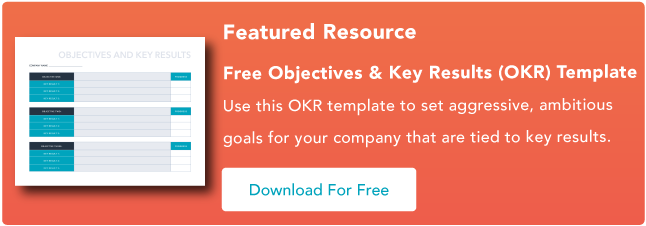You might already have a business strategy that keeps your organization running smoothly. But if you don’t set the right goals, you risk idling in place.

OKRs provide a structured framework with specific objectives and results, ensuring everyone knows what to do to achieve their goals. Setting OKRs helps you focus on growth, and research shows that leaders who do that see better long-term success.
In this article, we‘ll explore what makes OKRs an effective goal-setting and leadership tool and how you can implement them in your business. Let’s begin.
Download Now: HubSpot's Free OKR Template
What is an OKR?
An OKR is a collaborative goal-setting framework used by individuals, teams, and organizations to set and track ambitious, measurable goals. It creates alignment and drives goal achievement by ensuring everyone is working towards the same objectives.
OKRs are versatile and effective across contexts, from marketing campaigns to company management. Implement them at any company level and even for personal goal-setting to help you (and others) stay focused and achieve predetermined objectives.

Free Sales Plan Template
Outline your company's sales strategy in one simple, coherent sales plan.
- Target Market
- Prospecting Strategy
- Budget
- Goals
Download Free
All fields are required.

OKR vs. KPI
OKRs focus on setting high-level goals and figuring out the metrics to achieve them, giving you direction and context. In contrast, KPIs are standalone metrics that track your progress and tell you if you’re heading in the right direction. And while KPIs measure performance, they don’t always offer strategic context to guide your next steps.
That's why OKRs and KPIs are like peanut butter and jelly — they’re better together.
Rather than seeing OKRs and KPIs as rivals, think of them as the perfect pair. KPIs can be key results within your OKRs, thereby linking measurable outcomes to your big-picture goals. This then makes your goals meaningful and your progress trackable.
What does OKR stand for?
OKR stands for Objectives and Key Results. Let's decode each term.
Objectives
Objectives are the “what” — what you want to achieve. They are clear, actionable, and time-bound goals that give direction and purpose. Think of them as the big-picture outcomes you’re aiming for.
Key results
Key Results are the “how” — how you know you’re making progress towards your objective. They are specific, measurable, and time-bound outcomes that indicate whether you’re on track to achieving your goals. Key Results provide the metrics that keep you focused and moving forward.
History and Methodology of OKRs
OKRs were created in the 1970s by Andy Grove at Intel. Grove took Peter Drucker’s Management by Objectives (MBO) concept and enhanced it by adding measurable key results, making it easier for teams to track progress toward goals.
Years later in 1999, John Doerr, one of Grove‘s protégés, introduced OKRs to Google. This move played a crucial role in Google’s success, and soon, many other companies followed suit, using OKRs to drive growth and innovation.
Now, the magic of OKRs lies in their simplicity and focus.
Typically set quarterly, OKRs are designed to be challenging yet achievable, pushing teams to stretch their limits. Regular check-ins are key to staying on track and making adjustments as needed. This ensures everyone in the organization is aligned and working towards the same goals, keeping the team focused and making meaningful progress.
It’s like having a roadmap that shows you where to go, how to get there, and how far you've come.
OKR template
Creating OKRs is an admittedly comprehensive and time-consuming process.
Luckily, there's an easy way out: HubSpot’s Free OKR Template. Downloadable as an Excel workbook, Google Sheet, or PDF, it lets you add your company’s name, enter your objectives and key results, and track progress in the dedicated column. It’s designed to help you achieve your goals efficiently while keeping everyone aligned and motivated.
Download HubSpot’s Free OKR Template Today
How to Write an OKR
- Create clear, inspiring objectives.
- Determine specific and measurable key results.
- Cross-check alignment with business-wide goals.
- Invite team input.
- Ensure clear directives for team members.
- Regularly review and iterate.
- Document and celebrate progress.
1. Create clear, inspiring objectives.
Objectives should inspire and motivate your team while aligning with the company’s broader mission and vision. When writing your OKR, set ambitious and qualitative objectives that provide clear direction.
Tips to Write Clear and Inspiring Objectives
- Identify areas of growth: Setting OKRs should begin with identifying areas where your team needs to improve. Focus on gaps and opportunities for development. For example, if only 75% of sales reps met their quota last quarter, set an objective to increase that number by 10% by the end of the next quarter.
- Be bold and aspirational: Push your organization beyond its comfort zone. Instead of aiming to “Increase customer satisfaction,” go for “Become the industry leader in customer satisfaction.” Big goals spark innovation and exceptional performance.
- Adopt an integrated approach: Align your objectives with the overall company goals, team objectives, and individual targets. OKRs shouldn't exist in a vacuum—an interconnected approach ensures everyone is on the same page and moving in the same direction.
- Keep your company's future in mind: Focus on the bigger picture. Make sure each objective supports your company's long-term strategy and guides your team toward your ultimate goals.
- Explain “why” each objective matters: This context motivates teams and helps them understand each goal’s significance. For instance, if your goal is to become the most customer-centric company in your industry, your “why” could be to differentiate your company from competitors and build lasting customer loyalty.
2. Determine specific and measurable key results.
Key results are your yardstick — the tangible markers that show how close you are to hitting your objective.
Suppose you want a 10% increase in the number of sales reps that meet their quota. In this case, key results could include:
- Each sales rep spends one more hour per day finding more qualified prospects.
- Each sales rep books two more meetings per week than previously.
- Each sales rep closes eight more deals per month than previously.
Determining key results well is crucial. Here’s how to get it right:
Make them quantifiable and measurable.
You need crystal-clear results, with specific metrics attached, to monitor progress. For example, “Increase net promoter score (NPS) from 50 to 70.” See how specific that is? You'll know exactly what success looks like.
Focus on outcomes, not activities.
Instead of listing tasks, focus on the impact. For example, rather than saying, “Conduct ten customer surveys,” a more effective key result would be “Achieve a 20% increase in customer satisfaction scores from surveys.” This keeps your team zeroed in on what truly matters: the outcome.
Ensure they're time-bound.
Deadlines keep the momentum going and everyone accountable. Ensure each key result has a clear end date, like “Achieve a Net Promoter Score (NPS) of 70 by the end of Q4.” It creates urgency and helps prioritize efforts.
Be realistic about measurement.
Not everything is easy to measure, and that’s okay. You’ll just have to get creative with your metrics. For instance, if your objective is to boost corporate culture, use KPIs like increased retention rates, decreased turnover, or improved employee Net Promoter Scores (eNPS) to gauge success.

Free Sales Plan Template
Outline your company's sales strategy in one simple, coherent sales plan.
- Target Market
- Prospecting Strategy
- Budget
- Goals
Download Free
All fields are required.

3. Cross-check alignment with business-wide goals.
Next, comes the heart of OKRs: alignment.
Every OKR should be a purposeful step towards your company’s success. Below are some strategies to help you achieve this.
Connect levels.
Think of your OKRs like a set of Russian nesting dolls. You want to create that perfect fit where each level fits perfectly inside the next, with individual and team OKRs snugly supporting the bigger company objectives.
Promote transparency.
Make your OKRs visible to everyone in the organization. When everyone knows your goals and how each person contributes toward them, it fosters accountability and alignment.
Cascading goals.
Imagine a waterfall, but more organized. Start with top-level objectives and cascade them down. Company objectives shape departmental goals, which guide team goals, and ultimately influence individual key results. This cascading model ensures each OKR supports a higher-level objective.
For example:
- Company objective: Increase market share in the SaaS industry by 8% in the next year.
- Marketing team objective: Generate an 18% increase in qualified leads by Q3.
- Individual key result: Launch two major lead generation campaigns by the end of Q2.
- Individual key result: Increase website traffic by 15% by the end of Q2.
- Marketing team objective: Generate an 18% increase in qualified leads by Q3.
4. Invite team input.
When writing OKRs, don't make it a one-person job. Encourage feedback from team members closest to the work. You can also organize brainstorming sessions where participants share their perspectives and ideas.
This approach has a twofold effect:
- It improves the quality of OKRs
- It gets buy-in from the team
How? The people on the front lines often have the most accurate and up-to-date information about what’s happening in the trenches.
Using their knowledge will help you set key results that are both ambitious and grounded in reality. Plus, their experiences can highlight potential challenges and opportunities that may otherwise be missed.
More importantly, when everyone has a voice, the goal becomes a collective mission rather than a top-down directive.
5. Ensure clear directives for team members.
Each OKR should clearly define what individual team members need to do to achieve the key results.
Break down the objective into specific actions so each team member understands their individual roles and responsibilities.
Suppose your goal is to increase revenue by 20%. The key result is for each team member to spend one additional hour each week upselling five of their current clients, aiming to close one upselling deal per week.
This directive is effective because:
- Time-bound: The commitment of one extra hour per week is clear and manageable.
- Targeted: Upselling five current clients each week provides a focused task.
- Measurable: Closing one more upselling deal per week offers a specific target to achieve.
This not only drives accountability but also empowers individuals to see how their efforts directly contribute to the broader goal. Plus, it keeps things human and achievable.
6. Regularly review and iterate.
OKRs aren't a set-it-and-forget-it strategy. To stay effective, they need continuous monitoring and iteration.
- Weekly check-ins: During these check-ins, discuss the progress made, identify any obstacles, and adjust plans as necessary. Ask questions like “What progress have we made?” and “What challenges are we facing?”
- Quarterly reviews: At the end of each quarter, conduct a thorough review of your OKRs. Take the time to assess the outcomes, understand what worked well, and identify areas for improvement. Then, use these insights to set the next quarter’s OKRs.
In addition, consider implementing a simple scoring system (e.g., a scale from 0.0 to 1.0, where 0.0 means no progress and 1.0 means full achievement of the key result) to evaluate the success of each key result. Based on the tracked progress, assign a score between 0.0 and 1.0 to each team member. For example, if a team member reached out to five clients and closed one deal, they would score 0.6.
This will help you understand the effectiveness of your efforts and make necessary adjustments.
7. Document and celebrate progress.
Have a designated place to document your team’s progress toward your goal at the end of each week. This keeps your OKRs top of mind for your team — and everyone accountable for their role.
We recommend creating a progress table like the version below and reviewing it with your team every week:
|
WEEK 1 |
WEEK 2 |
WEEK 3 |
WEEK 4 |
|
|
October |
||||
|
November |
||||
|
December |
Last but not least, celebrate the wins and learn from failures.
Your team achieved a key result — or, at the very least, came close — and that’s worth celebrating. Give your team a shout-out, reward them, or hold small celebrations to boost morale and encourage the team to keep pushing forward.
As for losses, not all OKRs will be met, and that’s okay. Use setbacks as learning opportunities. Discuss what went wrong and how it can be avoided in the future. You can then start the process all over again and set better and more effective OKRs.
OKR Examples Across Business Use Cases
Sales OKR: Reaching Leads Goal
- Objective: Improve lead processes to increase the number of qualified leads.
- Time period: January through March of the current year.
- Key results:
- Key result one: Reduce the number of fields on the signup page to streamline the demo request process.
- Key result two: Respond to 80% of inbound inquiries within 12 hours.
- Key result three: Each rep demos the product to 25 new leads each week.
Customer Support OKR: Improving Customer Support Satisfaction
- Objective: Increase customer support satisfaction score to 90%, a 10% improvement over the current score of 80%.
- Time period: July through September of the current year.
- Key results:
- Key result one: Resolve 95% of support tickets within 24 hours.
- Key result two: Implement a new customer feedback system and collect feedback from at least 80% of support interactions.
- Key result three: Conduct monthly training sessions for the support team to improve response quality and empathy.
HR OKR: Boosting employee engagement
- Objective: Achieve an employee engagement score of 85%, up from the current score of 70%.
- Time period: January through March of the current year.
- Key Results:
- Key result one: Launch a new recognition program to highlight employee achievements and recognize at least 20 employees per month.
- Key result two: Organize quarterly team-building events and ensure participation from at least 90% of employees.
- Key result three: Implement a mentorship program and match 50% of employees with mentors by the end of the quarter.
Product development OKR: Streamlining product development cycle
- Objective: Reduce the product development cycle time by 20%, from 10 months to 8 months.
- Time Period: April through June of the current year.
- Key Results:
- Key result one: Implement agile methodologies and conduct weekly sprint reviews to ensure timely progress.
- Key result two: Increase the percentage of automated testing to 80% to reduce manual testing time.
- Key result three: Conduct a comprehensive review of the product development workflow and identify and eliminate at least three bottlenecks.
Benefits of OKRs for your business
- Enhanced focus and performance: OKRs help you and your team prioritize work by clearly defining what needs to be achieved and how success will be measured. This sharpens focus and ensures everyone is working towards the same high-impact goals.
- Improved alignment and engagement: OKRs create a transparent goal-setting process that aligns individual, team, and organizational objectives. When employees see how their efforts contribute to the broader company goals, their motivation and commitment increase.
- Increased accountability: With OKRs, accountability is built into the framework. Key results are specific, measurable, and time-bound, making it easy to track progress and hold teams accountable. Regular check-ins and reviews further ensure that objectives are kept top of mind and that progress is consistently monitored.
- Agility and adaptability: OKRs are typically set and reviewed every quarter, allowing you to remain agile and responsive to changes in the business environment. This regular review cycle enables you and your team to pivot and adjust strategies as needed.
- Encourages a culture of continuous improvement: By regularly reviewing and iterating on goals, you can identify areas for growth and development. Consider it an iterative process that helps you refine strategies and workflows to achieve better overall results.
The OKR framework is the key to sales success
The OKR framework can fit a variety of goals and initiatives that ultimately make your team more successful and accountable for their contributions to the overall objectives. Setting OKRs will drive your team toward success and empower you to exceed your organizational goals.
Editor's note: This post was originally published in September 2021 and has been updated for comprehensiveness.


![Creating Sales Goals as a Sales Manager [Expert Tips & 11 Examples]](https://blog.hubspot.com/hubfs/Manager%20Goals.jpg)

![The 9 Most Important Types of Sales Objectives [+Examples]](https://blog.hubspot.com/hubfs/Sales%20Objectives.jpg)

![The Top 10 Priorities for Sales Leaders in 2020 (and How to Achieve Them) [Infographic]](https://blog.hubspot.com/hubfs/sales-leader-priorities.jpg)